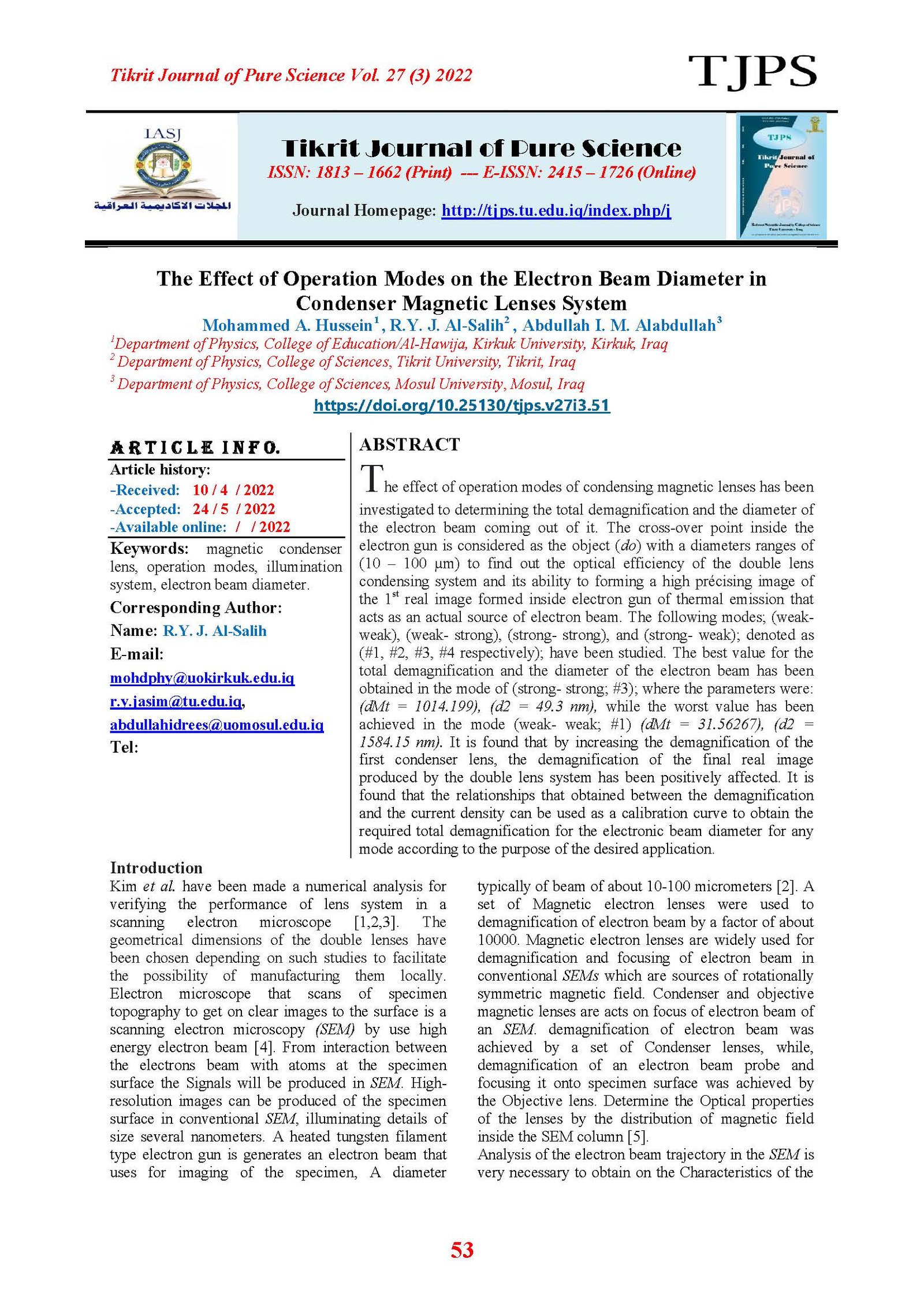The Effect of Operation Modes on the Electron Beam Diameter in Condenser Magnetic Lenses System
Main Article Content
Abstract
The effect of operation modes of condensing magnetic lenses has been investigated to determining the total demagnification and the diameter of the electron beam coming out of it. The cross-over point inside the electron gun is considered as the object (do) with a diameters ranges of (10 – 100 µm) to find out the optical efficiency of the double lens condensing system and its ability to forming a high précising image of the 1st real image formed inside electron gun of thermal emission that acts as an actual source of electron beam. The following modes; (weak- weak), (weak- strong), (strong- strong), and (strong- weak); denoted as (#1, #2, #3, #4 respectively); have been studied. The best value for the total demagnification and the diameter of the electron beam has been obtained in the mode of (strong- strong; #3); where the parameters were: (dMt = 1014.199), (d2 = 49.3 nm), while the worst value has been achieved in the mode (weak- weak; #1) (dMt = 31.56267), (d2 = 1584.15 nm). It is found that by increasing the demagnification of the first condenser lens, the demagnification of the final real image produced by the double lens system has been positively affected. It is found that the relationships that obtained between the demagnification and the current density can be used as a calibration curve to obtain the required total demagnification for the electronic beam diameter for any mode according to the purpose of the desired application.
Article Details

This work is licensed under a Creative Commons Attribution 4.0 International License.
Tikrit Journal of Pure Science is licensed under the Creative Commons Attribution 4.0 International License, which allows users to copy, create extracts, abstracts, and new works from the article, alter and revise the article, and make commercial use of the article (including reuse and/or resale of the article by commercial entities), provided the user gives appropriate credit (with a link to the formal publication through the relevant DOI), provides a link to the license, indicates if changes were made, and the licensor is not represented as endorsing the use made of the work. The authors hold the copyright for their published work on the Tikrit J. Pure Sci. website, while Tikrit J. Pure Sci. is responsible for appreciate citation of their work, which is released under CC-BY-4.0, enabling the unrestricted use, distribution, and reproduction of an article in any medium, provided that the original work is properly cited.
References
[1] D.H. Kim, K. Park, M.J. Park, H.W. Jung, D.Y. Jang, "Numerical analysis for verifying the performance of lens system in a scanning electron microscope", Optik (Stuttg). 121 330–338. https://doi.org/10.1016/j.ijleo.2008.07.012, (2010).
[2] E.K. Peter Hawkes, "Principles of Electron Optics", https://doi.org/10.1016/c2015-0-06653-9, (2018).
[3] M. Sapti, "A Textbook on Fundamentals and Applications of Nanotechnology", Kemamp. Koneksi Mat. (Tinjauan Terhadap Pendekatan Pembelajaran Savi). 53 1689–1699., (2019).
[4]M.A. Hussein, "Numerical analysis to verifying the performance of condenser magnetic lens in the scanning electron microscope", 58, 44–49. (2016).
[5]A. Khursheed, "Magnetic axial field measurements on a high resolution miniature scanning electron microscope", Rev. Sci. Instrum. 71, 1712–1715. https://doi.org/10.1063/1.1150525, (2000).
[6] M.A. Hussein, "Effect of the Geometrical Shape of the Magnetic Poles and the Distance between Them on the Focal Properties of the Condenser Magnetic Lens in the Scanning Electron Microscope", (SEM), 4, 130–134. https://doi.org/10.12691/ijp-4-5-3, (2016).
[7] R.F. Egerton, "Physical Principles of Electron Microscopy", https://doi.org/10.1007/978-3-319-39877-8, (2016).
[8] X. Zhu, "A computer program for electron gun design using second-order finite elements", J. Vac. Sci. Technol. B Microelectron. Nanom. Struct. 7, 1862. https://doi.org/10.1116/1.584681, (1989).
[9] Munro, E., "Computer-Aided Design of Electron Lenses by the Finite Elements Method", in Image Processing and Computer-aided Design In Electron Optics, edited by P. W. Hawkes, Academic Press, London, pp. 284-323., 1975a.
[10] R.Y.J. Al-Salih, A.I.M. Al-Abdulla and E.M.A. Alkattan., "Simple program for computing objective optical properties of magnetic lenses", Int. J. Computer Applications in Technology, Vol. 66, No. 3/4, (2021).
[11] S. Pany, B. Atomic, B. Dubey, "Development of electron beam focusing system for Scanning Electron Microscope", (2012).
[12] M.A. Hussein, " Design and Fabrication Illumination System in the Scanning Electron Microscope " thesis university of mosul , (2014).
[13] Q.W. Graciela W. Padua, "Nanotechnology Research Methods for Foods and Bioproducts", First Edit, A John Wiley & Sons, Ltd., Publication, USA, (2012).
